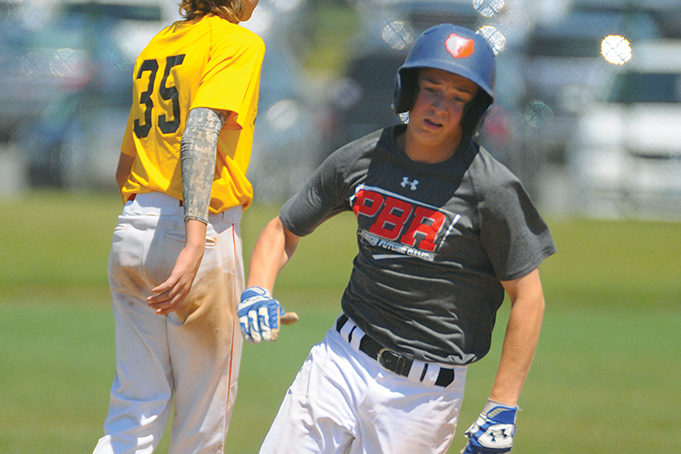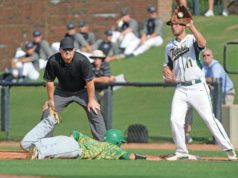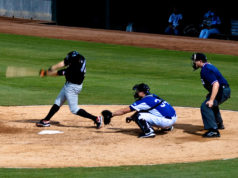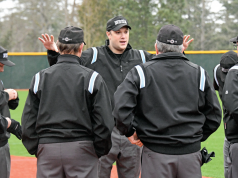If two runners pass each other on the basepath, one of them is out. The out is immediate, just as if a tag had occurred and the ball remains live (NFHS 8-4-2m; NCAA 8-5m; pro 5.09b9).
There is an exception if the lead runner had been obstructed and that is an even rarer occurrence than unobstructed runners passing. Also, a runner can only be declared out for passing an active runner; passing a retired runner is not an infraction.
The aspect of the rule that gives some umpires difficulty is determining which runner is out. The answer is simple — it’s always the following runner. So it doesn’t matter if the trailing runner passes a preceding runner or the preceding runner retreats past the following runner (pro 7.09b9 Cmt).
Here is a recent play from a prep game where the umpires almost got it right. With no one out, R1 is on first. B1 hits a trouble ball to right center and R1 plays it halfway. B1 “knows” it is going to drop and runs hard, passing R1. The ball drops, B1 realizes his error and retreats to first. The throw goes to second and beats R1 (he is not tagged); the subsequent throw to first is not in time to get B1.
The umpires let the play stand with R1 out at second and B1 remaining at first. The net result was sort of correct in that an out was recorded and a runner was on base, but the wrong runner was left on at the wrong base. In reality, B1 was out when he passed R1. That removed the force on R1, resulting in him being safe at second.
As it happens in some cases, a mechanics error creates the opportunity for a rules error. Neither umpire called B1 out, which should have been done immediately and loudly as soon as B1 passed R1. It should have been treated the same as if he had been tagged. However, both umpires were apparently watching the ball. The ball was in the “V” and was the base umpire’s responsibility. Because neither umpire recognized the significance of B1 temporarily passing R1, they believed both runners were live when the ball was thrown to the infield and the base umpire called out R1 on an apparent force play.
The passed runner did not escape the eyes in the dugout and the defensive coach came out of the dugout. Either through gamesmanship or a lack of understanding of the rule, the coach claimed a double play had occurred. To their credit, the umpires didn’t buy that, but acknowledged they had not noted that B1 had passed R1. It appears after the coach mentioned it, one of the umpires recalled seeing B1 get ahead of R1. After a long conference, the decision was made to let the play stand as called. The logic applied in doing that remains a mystery, but it wasn’t that it was too late to correct the error. The mistake could have been corrected because by rule the force on R1 was eliminated when B1 passed him even though B1 had not been called out.
With two outs, another dimension is added to these types of situations.
Play: With the bases loaded and two outs, B4 hits a home run over the fence. As R1 is watching the ball, B4 passes him between first and second before R3 touches the plate. Ruling: B4 is out for passing R1. In NFHS, the other runners may continue to touch all bases and score. The baserunning infraction does not negate the award even though it is the third out (NFHS 8-4-2m, 2006 Interp.). In NCAA and pro, it is a “time” play and no runs score. If R3 had touched the plate before the out occurred, his run would count (NCAA 8-5m, Interp.; pro 7.01g AR, PBUC 6.16).
A play very similar to the preceding example occurred in the longest perfect game in MLB history. On May 26, 1959, Pittsburgh Pirate southpaw Harvey Haddix was perfect for 12 innings. Leading off the bottom of the 13th inning, the 37th Milwaukee Brave batter, Felix Mantilla, reached first on a throwing error by third baseman Don Hoak. After Eddie Mathews sacrificed Mantilla to second, Hank Aaron was intentionally walked. Joe Adcock then lined Haddix’s second pitch over the left-field fence for an apparent three-run homer. Aaron, however, thought the ball was still on the field and headed for the dugout after touching second. Adcock was called out for passing Aaron when he reached third. Only Mantilla’s run counted for a 1-0 victory.
What's Your Call? Leave a Comment:
Note: This article is archival in nature. Rules, interpretations, mechanics, philosophies and other information may or may not be correct for the current year.
This article is the copyright of ©Referee Enterprises, Inc., and may not be republished in whole or in part online, in print or in any capacity without expressed written permission from Referee. The article is made available for educational use by individuals.


















